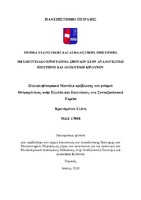| dc.contributor.advisor | Πιτσέλης, Γεώργιος | |
| dc.contributor.author | Κρατημένου, Ελένη | |
| dc.date.accessioned | 2020-08-27T09:57:27Z | |
| dc.date.available | 2020-08-27T09:57:27Z | |
| dc.date.issued | 2020-07 | |
| dc.identifier.uri | https://dione.lib.unipi.gr/xmlui/handle/unipi/12866 | |
| dc.identifier.uri | http://dx.doi.org/10.26267/unipi_dione/289 | |
| dc.description.abstract | Μια από τις πιο έντονες προκλήσεις της εποχής μας σε κοινωνικό και οικονομικό επίπεδο είναι η ραγδαία αύξηση της μακροζωίας και η γήρανση του πληθυσμού σε παγκόσμια κλίμακα. Στη προσπάθεια να αντιμετωπιστεί αυτή η πρόκληση αναπτύσσονται συνεχώς μοντέλα με σκοπό την πρόβλεψη του ρυθμού θνησιμότητας. Κύρια πηγή πληροφοριών για την ανάπτυξη αυτών των μοντέλων είναι τα ιστορικά στοιχεία, αλλά κρίνεται απαραίτητη και η κριτική σκέψη ειδικών επιστημόνων. Η παρούσα εργασία παρουσιάζει μερικά από τα κυριότερα μοντέλα θνησιμότητας της βιβλιογραφίας και δίνεται ιδιαίτερη έμφαση στο μοντέλο Lee-Carter (1992) καθώς είναι ένα μοντέλο ευρέως γνωστό για την πρόβλεψη της θνησιμότητας. Στη συνέχεια, αναλύονται τρία από τα κύρια πολύ-πληθυσμιακά μοντέλα, τα οποία έχουν ως βάση το μοντέλο Lee-Carter (1992) και παρέχουν τη δυνατότητα ταυτόχρονης μοντελοποίησης δύο και άνω πληθυσμών. Με δεδομένα από τον πληθυσμό της Ελλάδας, για άνδρες και γυναίκες, εφαρμόζεται η μεθοδολογία των μοντέλων και για τους δύο πληθυσμούς ταυτόχρονα και υπολογίζονται οι προβλέψεις των δεικτών θνησιμότητας. Έπειτα, κατασκευάζονται πίνακες θνησιμότητας με βάσει τους προβεβλημένους δείκτες θνησιμότητας με σκοπό την τιμολόγηση ασφαλιστικών προϊόντων. Σκοπός της εργασίας είναι να εξετάσει την προβλεπτική ικανότητα των πολύ-πληθυσμιακών μοντέλων θνησιμότητας δύο πληθυσμών σε σύγκριση με τις ανεξάρτητες προβλέψεις μέσω του μοντέλου Lee-Carter (1992). | el |
| dc.format.extent | 116 | el |
| dc.language.iso | el | el |
| dc.publisher | Πανεπιστήμιο Πειραιώς | el |
| dc.rights | Attribution-NonCommercial-NoDerivatives 4.0 Διεθνές | * |
| dc.rights | Attribution-NonCommercial-NoDerivatives 4.0 Διεθνές | * |
| dc.rights.uri | http://creativecommons.org/licenses/by-nc-nd/4.0/ | * |
| dc.title | Πολυπληθυσμιακά μοντέλα πρόβλεψης του ρυθμού θνησιμότητας στην Ελλάδα και επιπτώσεις στα συνταξιοδοτικά ταμεία | el |
| dc.title.alternative | Multi-population modelling of Greek mortality rates and applications to pension plans | el |
| dc.type | Master Thesis | el |
| dc.contributor.department | Σχολή Χρηματοοικονομικής και Στατιστικής. Τμήμα Στατιστικής και Ασφαλιστικής Επιστήμης | el |
| dc.description.abstractEN | Some of the most far-reaching social and economic challenges of the current age are caused by the rapid increases in longevity and aging of populations across the world. One strand of efforts to meet these challenges has been the development of a wide range of models in order to forecast the future evolution of mortality rates, based on a combination of statistical extrapolation of historical data and expert judgment. This paper presents some of the main mortality models in the literature and emphasizes the Lee-Carter model (1992) as it is a widely known model for predicting mortality. Then, three of the main multi-population mortality models are analyzed, which are based on the Lee-Carter model (1992) and provide the possibility of simultaneous modeling of two or more populations. Given data from the population of Greece, for men and women, the methodology of the models is applied for both populations at the same time and the predictions of mortality rates are calculated. Following this, mortality tables are constructed based on the predicted mortality rates for the purpose of pricing insurance products. The objective of this study is to examine the predictive capacity of multi-population mortality models for two populations compared to independent predictions through the Lee-Carter model (1992). | el |
| dc.contributor.master | Αναλογιστική Επιστήμη και Διοικητική Κινδύνου | el |
| dc.subject.keyword | Mortality rates | el |
| dc.subject.keyword | Population | el |
| dc.subject.keyword | Projection | el |
| dc.subject.keyword | Forecast | el |
| dc.subject.keyword | Pricing | el |
| dc.subject.keyword | Multi-population models | el |
| dc.subject.keyword | Lee-Carter model | el |
| dc.date.defense | 2020-07-13 | |



